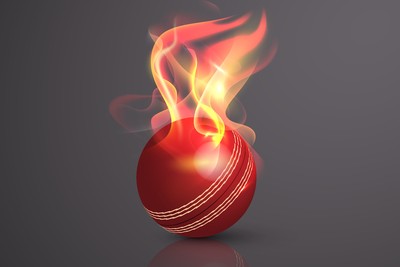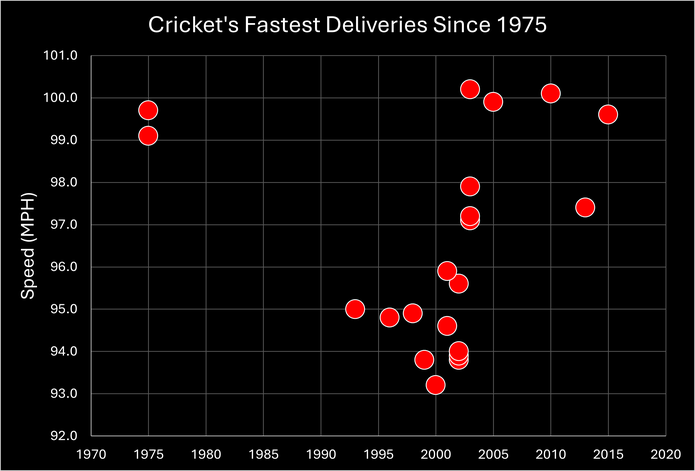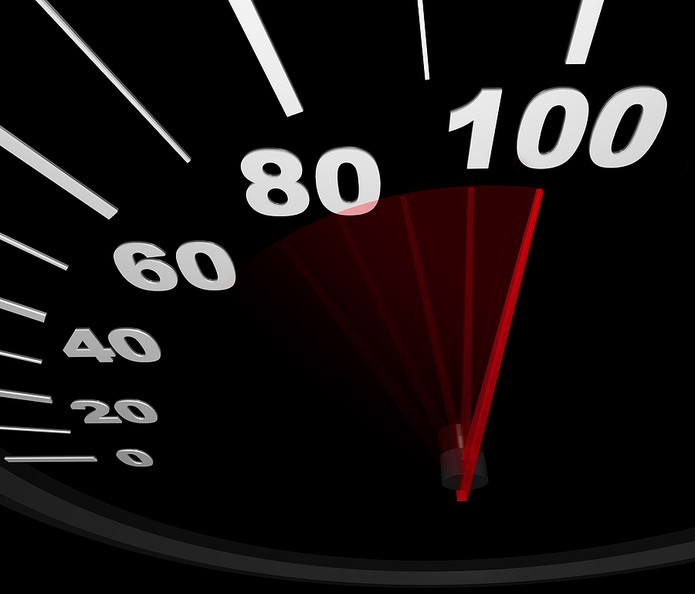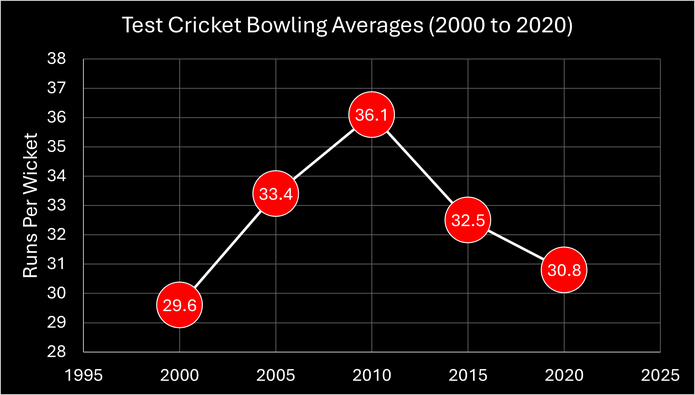 Control, skill and guile are usually the arbiters of success for a bowler in cricket – at any level of the sport, from the elite to the grassroots.
Control, skill and guile are usually the arbiters of success for a bowler in cricket – at any level of the sport, from the elite to the grassroots.
But there’s no doubt that sheer pace and raw power can put the wind up a batter, and when combined with skill, the individual is sure to be onto a winner.
One of the fastest bowlers in the history of women’s cricket, Shabnim Ismail, reached new heights in March 2024 when she delivered an 82mph ball in a Women’s Premier League game in India – the first time ever that a female had smashed the 130km/h mark.
Superb Shabnim ⚡
Congratulations to Shabnim Ismail who made HER-STORY as she recorded the fastest delivery in women’s cricket 💨🏃♀️#WozaNawe #BePartOfIt pic.twitter.com/nX4DpN9O8t
— Proteas Women (@ProteasWomenCSA) March 6, 2024
The ball was too fast for batter Meg Lanning to handle, cannoning into her pads – fortunately for her, the LBW shout was turned down.
What’s interesting about the delivery is that Ismail, who has long been the fastest bowler in women’s cricket, is now 35-years-old, retired from international cricket and winding down her 18-year career at the top level.
The South African once reached 79.5mph in an international game against the West Indies in 2016 – at the time, that was the fastest ball in women’s cricket since speeds have been recorded.
It was once claimed that Elysse Perry had bowled 130km/h in an WPL game back in 2023, although the accuracy of the speed gun was questioned – the Australian rarely gets above 120km/h on a normal day.
Many believe that 80mph bowling will become the norm soon enough – including England’s speedster Issy Wong, which confirms the upward trajectory in pace in women’s cricket.
But is the same true for pace bowlers in men’s cricket?
What is the Fastest Delivery in Cricket History?
One of the challengers when comparing pace bowlers of all generations is that speed guns haven’t always been used – decades ago, statisticians were forced to use rather more rudimentary methods of recording bowling speeds, which therefore cannot always be considered particularly accurate.
But for speeds that have been officially recorded and independently verified, Shoaib Akhtar is responsible for the fastest delivery in cricket history.
The Pakistan paceman sent down a 100.2mph thunderbolt while representing his country against England at the 2003 World Cup – no wonder his nickname was the Rawalpindi Express.
Indeed, that was the first time that a bowler had crossed the 100mph threshold – Shaun Tait became the second in 2010 for Australia playing against England. Who knows how much faster Tait would have become had he not been forced to retire from first-class cricket aged 25 due to injuries.
As far as the official record books are concerned, those are the two occasions in which the 100mph ceiling has been broken – although a small handful of bowlers have come very close to joining the club too.
Cricket’s Fastest Recorded Deliveries
| Bowler | Year | Speed |
|---|---|---|
| Shoaib Akhtar | 100.2mph | 2003 |
| Shaun Tait | 100.1mph | 2010 |
| Brett Lee | 99.9mph | 2005 |
| Jeff Thomson | 99.8mph | 1975 |
| Mitchell Starc | 99.7mph | 2015 |
It’s interesting that of these five fastest deliveries in cricket history, only once came before the year 2000 – the other four have been bowled since then, however there hasn’t been a new addition to the list since 2015.
Indeed, zoom out to look at the ten fastest deliveries of all time (that have been recorded), and we notice that another four came between 2003 and 2013 – so, all things considered, eight of the ten fastest balls ever bowled were sent down between 2003 and 2015.
So are cricket’s pace bowlers getting faster? They were, but since 2015 they seem to have reached a plateau. Here’s a look at the 21 fastest deliveries ever recorded against the year they were bowled:

As you can see, that period between 2000 and 2015 saw an incredible uptick in bowling pace – but it has fallen off a cliff since, which is a surprise when you consider that in women’s cricket, the speed gun is getting cranked up higher year on year.
So why is this? We’ll try and figure that out later in this article.
Who are the Fastest Bowlers in Cricket History?
So we know that Shoaib Akhtar delivered the quickest ball in history, but it would be wrong to suggest that he was consistently the fastest bowler the sport has ever seen.
Injuries certainly didn’t help him – a consequence of putting the body through such physical strain on a regular basis, but there has certainly been bowlers who have regularly been clocked in the upper 90mph bracket over a prolonged period of time.
Brett Lee – Australia
One of Akhtar’s contemporaries, Brett Lee, was able to do just that. When Australia played Pakistan in a test match in the year 2000, Lee reached a top speed of 96.1mph but was recorded at an average of 94.4 mph throughout the game – surely one of the fastest continued spells of bowling ever recorded.
What’s interesting about the Aussie is that he bowled his fastest ever ball – that 99.9mph missile against New Zealand – in 2005, meaning that he was able to maintain his ferocious pace for more than five years. That has to make him one of the speediest speedsters in cricket history.
Jeff Thomson – Australia
Another Aussie, Jeff Thomson, can lay claim to the title. There’s a general feeling that the equipment used to record bowling speeds in the 1970s was somewhat inaccurate – those who faced his bowling claim that ‘Thommo’ was far quicker than the speed gun suggested.
His top recorded speed puts him on the all-time list anyway, but it’s the consistency with which Thomson was able to bowl fast that sets him apart from many of the other quicks – he was, for the most part, resistant to injury, and therefore able to bowl faster for longer.
What makes the speeds of Thomson and some of his contemporaries, such as the great West Indian, Michael Holding, so impressive is that they came from an era that was, shall we say, naïve when it came to sports science. Those guys wouldn’t have enjoyed the sheer wealth of nutritional knowhow that today’s players benefit from, nor would they have had support staff such as masseuses and conditioning coaches to fall back on.
And the boots they used to wear to bowl in….they were more hike than Nike, that’s for sure. With today’s breakthroughs in sports science and footwear engineering, who knows how fast Thomson and Holding would have been.
Current Bowlers Not up to Speed
Others, including Andy Roberts, Dennis Lillee and 1950s speedster Frank Tyson, would also come into the conversation, but it’s amazing how few bowlers of the current era – let’s say 2020 to today – would feature in a discussion for the fastest bowler of all time.
As if to emphasise that point, the BBC used 87mph as its benchmark pace when considering the speeds of English and Australian bowlers during the Ashes series of 2017 – a sure sign that the average rapidity has been on the decline.
There are anomalies – during the 2023 Ashes, Mark Wood bowled the fastest over ever seen at Headingley, averaging a shade over 93mph for the six balls he bowled. You wonder how rapid the Englishman would have been, or could be, but for the injuries and surgeries that have decimated his career.
Has Anyone Ever Bowled at 100mph?

As we’ve learned already in this article, two men have broken the 100mph barrier – Shoaib Akhtar and Shaun Tait.
But why haven’t more been able to do it, and will we ever see a bowler capable of hitting 100mph ball after ball, spell after spell? The history books would suggest that it’s highly unlikely given the scarcity of 100mph bowling over the years, and the absence of truly quick bowlers since 2015.
It’s strange, because in other areas of sport we are, as a species, getting collectively faster, fitter and stronger. Take a look at the progression of the 100m world record or the best marathon times – modern athletes benefit from increased awareness of nutrition, smarter gym routines and streamlined equipment, which all leads to a more holistic approach to enhanced performance.
There’s many other examples too – take a look at how many weightlifting world records have been broken since 2018, for instance – to know that sporting prowess continues on the up and up.
By this logic, cricketers too should be faster, fitter and stronger – and, in some ways, they are. Just look at how many sixes are being hit in all forms of the game now, and the distances that the ball travels; gym-honed batters, armed with more precision-engineered bats, are changing the landscape of cricket forever.
But bowlers, well, they continue to charge in and hurl that 5.5 ounce ball of red leather down as fast as they can – it’s just that they aren’t able to do it as speedily as their predecessors.
Brain Over Brawn

Perhaps truly fast bowlers do still exist in cricket – they’re just not being given the chance to prove it.
There’s no doubt that cricket, like many sports, has undergone a data revolution in its modern era. Stats are collected on pretty much every top-flight competition played around the world, including ball-by-ball analysis – allowing coaches to see the areas in which batters thrive and where they have a weakness.
For example, David Warner has long struggled against right-arm seamers bowling around the wicket at him, while modern day greats like Virat Kohli and Hashim Amla have, at times, shown a weakness playing balls on a good length just outside off stump.
Collating data is one thing, but actioning its findings quite another. If you were bowling at Warner, Kohli or Amla, you would have a good idea of where to bowl – but you need the bowlers at your disposal to act upon the conclusions of the number-crunchers.
Speed Versus Accuracy
Those that strive for pace and pace alone can try too hard to hit 100% velocity – often losing their radar, which can lead to loose balls that are easily picked off by the batters….whether they’re 95mph or not.
So, in enacting plans to dismiss a specific batsman, a bowler is likely to sacrifice pace in a bid for control and accuracy – knowing that that is their best chance of success. Some bowlers will even go through the motions physically, not reaching anything like their full capacity but instead bowling a tight line as desired by their coaches and captain.
Glenn McGrath, accepted as one of the greatest bowlers of all time, was not quick by any means. But he tortured batters with his metronomic accuracy and control.
“I never set a batsman up by giving him runs. I could not bring myself to do that,” the Aussie had said.
This confirming that skill – rather than pumping iron and tossing medicine balls around – was the foundation for his success.
Batters can practice in the nets against 95mph deliveries – they simply crank up the bowling machine and practice getting into line, albeit with less of a reaction time. But a bowling machine cannot replicate the craft of a bowler like McGrath, whose ability to land the ball on a sixpence, seaming it a little this way or that, had batters on toast for more than a decade at the top level.
Bowling fast is fun and can terrify batsman, but it’s not a guarantor of taking wickets – being skilful and accurate often is, hence why so many aspiring young bowlers find themselves slowing down in a bid to hit the right lines and lengths more often.
Are Bowlers Getting Better in Cricket?
At the start of this article, we set out to determine whether bowlers in cricket are getting faster – the evidence suggests not, even if the average pace is creeping up, the top speeds of the sport’s premier bowlers has fallen.
But what’s interesting is that while speed may have fallen, skill has crept up – as confirmed by the bowling averages, year on year, in test cricket:

Can you remember earlier, when we provided a rundown of the fastest deliveries ever bowled? In that era of pure, unadulterated pace, the average bowling average (if that makes sense) rose to 36.1 in 2010 at a time when quick bowlers were reaching the absolute limit of the speeds they could bowl.
By 2020, and remember that there had been no additions to the list of the all-time fastest deliveries since 2015, that average bowling average had fallen to 30.8 – the lowest since the year 2000.
There seems to have been a conscious, almost deliberate decision within cricket between around 2003-2015 – to bowl as fast as humanly possibly. But that meant that the bowlers were wilder and looser in turn, going for more runs (as evidenced by the averages).
At some point in the late 2010s, that trend had been reversed – suddenly bowlers were slowing down a little, taking some of the pace and effort out of their attack and instead focusing on accuracy and precision. The dropping bowling average is one of the side affects of this brain over brawn philosophy.
We’ve already alluded to it, but the impact of data in the late 2010s also cannot be overlooked. The England team of 2019 was one of the very first to truly embrace deep stats, not just the surface level stuff churned out on TV broadcasts, and they were rewarded with a World Cup win that very same year.
When one leads, others follow – as other international teams started using data, understanding how it could give bowlers the edge over opposing batters, it’s no surprise that reckless pace was replaced by thoughtful control.
So will we ever see the return of true fast bowling in cricket? Unless anomalies come along that can bowl at 100mph regularly – once-again creating a paradigm shift, cricket will remain a data-powered sport that rewards the carrying out of tactical plans over raw, spontaneous bursts of pace bowling aggression.